Running electricity to your shed or outbuilding will allow you to do more things with the space. There are many things to consider about installing electrical wiring, outlets, breaker boxes, and other electrical components.
I’ve wired a number of sheds – both new builds but also retrofitting electricity into older sheds. Working with electricity is no joke – you need to know what you are doing.
Before buying wiring, you need to get the electrical codes from your city or county officials. If you live in a rural area, you may even have to ask your electric company if there are any specific codes or regulations regarding installing electric wire in your shed or outbuilding.
The following information should help answer many of your questions about electricity in sheds.
Do I Need Electricity in My Shed?

Having electricity in a shed increases the things you can use the building for. To determine if electricity will be beneficial for you, you should first consider what the shed will be used for.
More often than not, having electricity in a shed will prove useful — even if it is so you have an outlet for the occasional need to plug something in.
Here are a few common shed purposes that could benefit from electricity (or require it) include:
-
- Installing an appliance such as a washer or freezer
- Using air conditioning or heat
- Access to lighting after dark
- Using a shop vac, battery charger, or other temporary device that requires an outlet, especially nice for working on lawnmowers or other small engines
- Equipping workrooms and workbenches with full power and charging abilities
- Getting internet to your shed and running the routers and hubs required for it
Shed purposes that don’t necessarily require electricity include:
-
-
- Storing garden tools
- Storing ornaments and clothes
- Feeds, cleaners, etc
- Storing firewood
-
In almost every situation, electricity helps inside a shed. Even when you store tools and things not used often when you go inside the shed, having an electric light to illuminate the interior makes finding what you are looking for easier.
FAQ About Running Electricity to Sheds

Is a permit required?
In most places, you must have a permit to install electrical circuitry into a shed or outbuilding.
How do you find out if you need a permit? Most cities, municipalities, or counties now have their codes online, so by going to their website, you can see for yourself what is required. You can always call the offices, too.
Do I need to hire an electrician to run electricity my shed?
In many cases, you will have to hire a certified electrician to run your shed’s electrical wiring and components. If the electrical wiring was put in it by the manufacturer, you may not need an electrician. You will only need to connect the shed to your power supply.
CAUTION: It is highly recommended that you hire a certified electrician to make any electrical changes, connections, or installations. Electricity is not something you want to learn through trial and error methods. To be blunt, you can get killed if you do it wrong.
Before you can buy insurance for the shed or the contents of the shed, you will need to prove that an electrician did the work on the electrical components of the building.
What size drill bit do I need to make the holes for the electric wires in the studs?
Generally, if you use Romex wire, a 3/4” paddle bit will make the perfect size hole through the studs.
Do I need to run my electrical wiring through in conduit?

You will need a copy of your town or county building codes, specifically their electrical codes, to determine if the conduit is required. The conduit is necessary for most places that require you to inspect the wiring before you can hang your wall boards. Conduit protects the wiring from being nicked, getting wet, and pests like rodents that might gnaw on it. It is always a great idea to use a conduit as a protector.
To make the conduit easier to run, you can buy a flex conduit that has some give and allows you to make tricky turns or drops with the wiring.
What size electrical wiring do I need for my shed?
The size of the electric wire you choose will depend on what you will power. If you have an appliance that needs 220 V or 240 V, you need a minimum size of 10/2.
If you are only running lights or things that can be powered by 110 V, you can use 12/2 wiring.
Remember that with electrical wiring, the smaller the number, the more current the wiring can handle. So a 10/2 wire can conduct more electricity than a 12/2. When you start providing power for electric stoves and heavy appliances, you may require an 8/2 or 6/2.
If you have a 20-amp circuit breaker, you can use 12/2 Romex. If you have a 30-amp circuit breaker, you need a 10/2 wire.
Will the shed need its breaker box?

If you are going to have an electric light and one outlet in the building, it likely does not need a breaker box. Of course, that is assuming that the structure sits close enough to another facility that has an electric breaker box with available space for an additional breaker.
If you have appliances of any type, including heat or cooling units, for the structure., you must run a dedicated service line for the shed and install a breaker box. A breaker box with a main breaker inside the shed is safer and will help prevent possible fires.
Do I have to run the electric cables to my shed underground?
If the shed is going to be a permanent fixture on your property, then an underground cable is a safe option. You will not have to worry about limbs falling across the power line and breaking them or the powerlines being knocked over during high winds.
If you run the wiring underground, you need wiring rated for the underground. That wiring must be run in a PVC conduit to protect it from exposure to water. The conduit can also protect you from digging and hitting the electric wire.
Above-ground wiring always has a more significant potential of being a safety hazard than underground wiring.
How much does it cost to run electricity to a shed?
Many variables must be considered when determining the cost of wiring your shed, as they could dramatically impact your overall shed cost.
- How close is your shed to electrical lines or cables?
- What size wire do you need? 12/2 is cheaper than 10/2.
- Do you need underground-rated wiring? Underground wiring is more expensive.
- Are you running the wiring through the conduit?
- Are you drilling the holes and running the wire yourself?
- Are you hiring an electrician to run the wire and make the connections?
- Do you need to buy a permit?
- Do you need to install a junction box or a breaker box?
- How many circuits are you running?
- How many outlets will you need?
Each decision from the list above will increase or decrease the cost of wiring your shed.
Before you can determine the cost, you will have to:
- Create a layout where all outlets, light fixtures, and witches will be in the shed.
- Know where any 220 V appliances will be sitting. (These appliances need dedicated circuits)
The cost of running electricity to a shed may be anywhere from $500 to a thousand dollars or more. This will depend on your needs and the cost of supplies and electricians in your area.
- If you already have electricity within the vicinity of the shed, the shed is unfinished, and you simply want a few outlets in the shed, and can safely do the work yourself, budget up to $500
- If you need to hire an electrician, add another $500
- If a finished shed needs to be retrofit for electricity or you are looking for more extensive wiring, you can easily get into the $1,000 to $2,000 range.
Benefits of Running Electricity to Your Shed
• Increase the value of the structure. A big benefit of having electricity in the shed is that it will be more valuable – both to you and a future buyer.
• You can use the building for more purposes. You open up the shed to be many things – workshop, a place to keep pets, etc. – if you have some electrical in it.
• It is more convenient to look for things inside the unit. Having some light really makes a huge difference.
• You can temperature control the room. You can turn a 2-season shed into a 4-season shed.
We are used to the convenience of electricity. You can install plenty of windows, battery-powered lighting, or skylights in your shed for illumination, but for most purposes running electricity to your shed will not cost very much and will benefit you greatly.
Be safe, and even if you do not intend to hire an electrician, take the time and talk to one before you start pulling the wire. Your safety is worth more than the few bucks you will spend to get advice or work done for you.


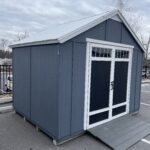
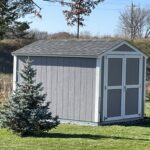
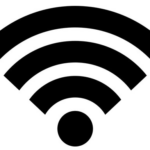
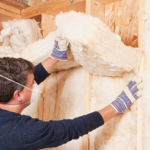
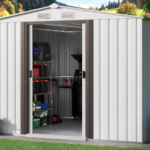






If I install a small air conditioner up high can I leave it in “on” mode on a low setting and turn it off and on from a wall switch?
Yes, assuming you have the right outlets for the AC voltage, that should be something that would work quite well.